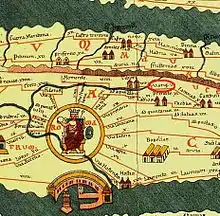Horace's Villa
Horace's Villa is a Roman archaeological complex near Licenza, Italy. The identification has been made possible because Horace wrote several poems about the place, and the location of the villa corresponds to the geographical indications in the poetry.
Villa Romana di Orazio | |
.jpg.webp) Drawing of the villa | |
 Shown within Italy | |
| Location | Licenza, Province of Rome, Lazio, Italy |
|---|---|
| Type | Dwelling |
| History | |
| Cultures | Roman |
| Site notes | |
| Condition | Ruined |
| Ownership | Public |
| Public access | Yes |
The site can be visited today.[1]
Identification
It was owing to references to the villa in Horace's writings that humanists attempted to find the site as early as the mid-fifteenth century, but the site in Licenza was not considered as a possible candidate for two hundred years. This changed when an inscription mentioning a temple of the goddess Victory was found in nearby Roccagiovine.

Horace tells in one of his poems (Epistles 1.10) that his villa was next to the sanctuary of the Sabine goddess, Vacuna. Lucas Holstenius (a mid-17th century geographer and a librarian at the Vatican Library) identified the sanctuary with the temple of the goddess Victory mentioned in the inscription, and he showed that the Romans associated the Sabine deity with their goddess Victoria. A confirmation of Holstenius' thesis came in 1757 with the discovery of the massa Mandelana inscription near Cantalupo (Mandela), which helped antiquarians to identify yet another place name mentioned by Horace as being near his Sabine estate.
Description
The Aniene Valley to the east of Rome is rich with archaeological remains. The Roman villa on the east slope of the Colle Rotondo (980 meters above sea level) in the Lucretili Mountains near the hilltown of Licenza is one of the best preserved and most significant sites. Attributed by most scholars since the 18th century to the Roman poet Horace, this villa dates from the first century B.C. and is located just 30 miles from the center of Rome in a valley near Vicovaro and Hadrian's Villa at Tivoli.
The actual site was identified and a small portion was excavated in the 18th century. Major excavations were undertaken in the early 20th century. Thus far, the main residence of the estate has been identified, covering, in the imperial period, some 40 x 110 meters of built space and gardens. Black and white mosaics (formerly dated to Horace's lifespan, but now known to be from the Flavian dynasty), marble wall revetment and architectonic elements, an elaborate water system, and artistic and utilitarian remains have been found. A selection of the material is on display in the local museum in the town of Licenza.
References
- "Horace's Villa at Licenza". Archived from the original on 2 April 2018.
